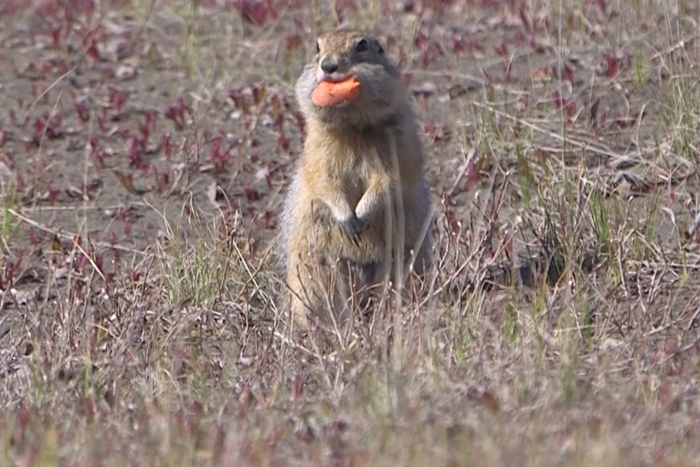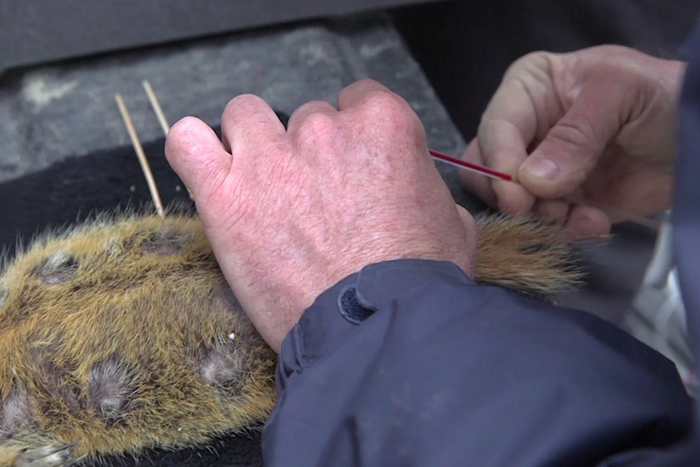
Arctic Squirrels Share Circadian Secrets (VIDEO)

Charlie Heck, multimedia news editor at the U.S. National Science Foundation, contributed this article to Live Science's Expert Voices: Op-Ed & Insights.
The Arctic ground squirrel has developed highly specialized adaptations to extreme environments, including circadian rhythms ("biological clocks") that persist throughout the Arctic summer, despite near-constant daylight hours. The animals' body clocks have evolved to work just fine without the help of the day/night cycle, which is also important to other animals, including humans. Problems with circadian rhythm have been linked to such issues as fertility, obesity and cancer.
To study the squirrels' unique adaptation, a team of researchers approached the U.S. National Science Foundation(NSF). With support from the NSF Directorate for Biological Sciences, physiological ecologist Cory Williams of the University of Alaska, Anchorage, and a team of fellow researchers traveled to the Toolik Field Station in northern Alaska to study the Arctic ground squirrel on its home turf. Part of the field research involves switching up light and temperature for the squirrels, essentially giving them a case of jet leg to gauge their reaction. [Resetting Our Clocks: How the Body's Tiny Timekeepers Work]
Back in Anchorage, environmental physiologist and project lead Loren Buck works with squirrels in his lab year-round. Buck says body clock disruptions are linked to many human ailments — seasonal affective disorder, obesity, cardiovascular disease, Alzheimer’s, and even cancer. (This research is being conducted in collaboration with a team of scientists at the University of Alaska, Fairbanks.)
Below, Williams answers questions about the research.
Charlie Heck: How can the squirrels' ability to adapt to constant daylight lead to treatments for human sleep disorders?
Cory Williams: We are conducting basic science research on the capacity of arctic ground squirrels to maintain entrained circadian rhythms under the midnight sun. So, I want to stress that our research will not lead directly to sources of treatments for human sleep disorders — but we do know that human sleep disorders, and many other diseases, are associated with breakdowns in circadian clock function. We also know that humans living at high latitudes tend to be more prone to sleep disorders and that, without an external clock, humans do not seem to be capable of maintaining entrained circadian rhythms during the polar day (constant daylight well above the arctic circle).
Sign up for the Live Science daily newsletter now
Get the world’s most fascinating discoveries delivered straight to your inbox.

And yet, our research indicates arctic ground squirrels can maintain entrained circadian rhythms throughout the arctic summer. So one of the major questions for us is how are they able to do this —what are the mechanisms involved? At this stage, we aren't even sure what environmental cue they are entraining to, though we suspect that they are sensitive to subtle variation in the intensity or color temperature of light. Basic science is about uncovering these kinds of mechanisms. We can't say for sure that this will lead to any particular treatments for disruptions in clock function, but increasing our understanding of circadian clock function in an animal that does not suffer from these types of disruptions is a good place to start.
C.H.: How difficult are Arctic ground squirrels to handle?
C.W.: They're not too bad to handle. We have custom-made handling bags that we use in the field that attach to our traps — when we open the trap door the squirrel runs directly into the bag. We can then weigh the squirrels and attach ear tags through mesh openings in the bag. For some of the work we do, like attaching collars with radio-transmitters and light loggers, we will anesthetize the squirrel because this is less stressful for them — and we don't want to get bitten. Squirrels in the lab tend to be more aggressive, but we can move them quickly and easily between tubs or cages either by wearing thick leather gloves or by providing them with a metal or PVC tube to hide in and then moving the whole tube.
C.H.: Would you rather work with the squirrels in the field or in the lab?
C.W.: I'd much rather work with them in the field, partly because it means I get to go to amazing places, like Toolik Field Station in Northern Alaska. But also because I think that there are so many questions in ecology and physiology that you just can't answer in the lab. If you want to understand the ecological and evolutionary significance of the physiological or behavioral traits you're interested in, you need to be in the field. And with improvements and miniaturization of electronic loggers, we can address a lot of questions in free-living animals that we just couldn't before. At the same time, there are still a lot of questions we can't answer in the field — particularly when we start looking at some of the molecular and genetic mechanisms. So, I think combining field and lab approaches is always going to be the best approach.
C.H.: Why don't the squirrels just hibernate like bears?
C.W.: Arctic ground squirrels do hibernate, but their hibernation physiology is different from large hibernators like black bears or brown bears. This difference is mostly due to size. Brian Barnes from the University of Alaska, Fairbanks, who is our principle collaborator on our arctic ground squirrel project, has studied black bear hibernation extensively and he's shown that hibernating black bears suppress their metabolism (the amount of energy they are consuming) to about 25 percent of basal (non-hibernating) levels while body temperature is regulated between 30 degrees Celsius and 36 degrees Celsius ("normal" body temperature is around 37C to 38C).
Although the energetic savings bears achieve are impressive, this wouldn't be nearly enough for a small hibernator like a ground squirrel, because small animals have a much higher metabolic rate per gram of tissue. What this means is that small hibernators simply couldn't store enough fat to survive a winter of hibernation with only this relatively moderate decrease in metabolism. What small mammals do instead is enter a physiological state called torpor, in which they suppress their metabolism to a much greater degree (as low as 2 percent of basal levels) and regulate their body temperature at much lower temperatures (as low as -2.9C in arctic ground squirrels, the lowest body temperature measured in a mammal).
Typically, body temperature during torpor is close to ambient temperature, but because arctic ground squirrels live in such an extreme environment, their hibernacula (the location chosen by an animal for hibernation) will be at temperatures well below the freezing point. They prevent themselves from freezing by generating heat using a specialized organ called brown adipose tissue or BAT. Small mammals don't remain torpid (at really low body temperature) throughout hibernation but instead they will undergo an arousal every two to three weeks, during which their body temperature returns to "normal" levels for less than 24 hours before they drop back into torpor again. This torpor-arousal cycle continues throughout their hibernation.

C.H.: What are the next steps in your research?
C.W.: Our circadian rhythms research is still ongoing. One of our major goals is to assess whether the master circadian clock, located in the hypothalamus, continues to function during deep torpor and the inter-bout arousals that occur during hibernation. Our collaborators, Brian Barnes (University of Alaska Fairbanks) and Lily Yan (Michigan State University), are working on this question right now. We also have experiments underway examining whether captive ground squirrels are capable of entraining their circadian clocks to subtle changes in the intensity or color temperature of light. Right now, I'm in the midst of planning our next field season — we have light loggers and body temperature loggers deployed on ground squirrels at our field sites and we will be recovering those loggers when the squirrels emerge from their hibernacula in the spring.
Follow all of the Expert Voices issues and debates — and become part of the discussion — on Facebook, Twitter and Google+. The views expressed are those of the author and do not necessarily reflect the views of the publisher. This version of the article was originally published on Live Science.









